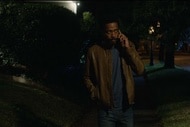Create a free profile to get unlimited access to exclusive videos, sweepstakes, and more!
Remembering the endless creative audacity of Anne Rice
In a career spanning six decades, Anne Rice never stopped inventing and reinventing.

Anne Rice was everywhere when I was a kid.
Like fellow bestselling icons Stephen King, Tom Clancy, Patricia Cornwell, and others, her books adorned the spinner racks at every supermarket, the tables at every price club, and the must-read shelves at every bookstore. Relatives had massive copies of The Witching Hour and The Queen of the Damned stacked on their night tables, and friends' parents had paperbacks of The Vampire Lestat tucked away in closets. Even before I knew who she really was, and what she really wrote, this woman and her seemingly endless novels about vampires, witches, and other dark creatures were a part of my life, and seeing their ubiquity led me to wonder: How could someone write this much stuff about the same thing?
But that's just it: Anne Rice never wrote about the same thing twice, not really.
Against the wishes of my parents, who'd heard too many suspect things about Rice's fiction to let me read her in my early teens, I was determined to find out. Eventually, thanks to the combination of Neil Jordan's excellent Interview with the Vampire film making its way to television and the lucky discovery of the first four books in The Vampire Chronicles at a family yard sale, I made my way into Rice's dark world. What I found when I got there was one of the most audacious popular authors I've ever encountered, even by the inventive standards of genre fiction, someone who dared to take massive leaps with her characters and mythologies with every single book. As a teenager, it was enough to set my brain on fire.
If you know any Anne Rice story, you know Interview with the Vampire, her debut novel that grew out of a short story she wrote and eventually became one of the most popular stories in all of vampire fiction. On the surface, it's a fairly straightforward novel with a great conceptual hook: A vampire consents to an interview and tells the story of his life. It's the kind of thing readers of popular fiction were primed to devour, but it also set the timeline for the confessional, deeply emotional nature of Rice's fiction, and through characters like Claudia (inspired by Rice's own daughter, who died very young) and her Byronic icon Lestat de Lioncourt, it built a world that Rice would eventually weave into an epic.
But of course, Rice didn't immediately launch into a 10-plus book series about her vampires. First she turned to historical fiction, writing novels about free people of color in Louisiana and opera singers in Italy. Those books didn't catch fire like Interview did, so Rice ultimately returned to the world of her debut with The Vampire Lestat, a book which promised to tell the life story of Interview's antagonist. Though Interview put her on the map, it was this book, and the way she chose to tell Lestat's story, that would come to define the way she governed her audacious creative career.
The Vampire Lestat, you see, does indeed tell the story of Lestat's early life as a brash French nobleman whose ferocity of spirit attracts a vampire who gives him the Dark Gift, but whatever restraint Rice may have been exercising with Interview falls away when she reveals that, after the first novel, Lestat retreated into slumber in the dirt of New Orleans, only to be awakened again by the sounds of a rehearsing 1980s rock band. Lestat rises, claims the band as his own, makes himself into a glamorous frontman, and decides to live his life out in the open, drawing the ire of other vampires along the way. It's a thrilling, intoxicating merging of young and old (something Interview helped set the template for), of operatic and punk, of melancholy and joy. It's a landmark work in paranormal fiction and she could have easily aped its style for a dozen more books and hit the bestseller list every time.
But she didn't.
Instead, Rice somehow went even further with the next Vampire Chronicles novels, giving us the secret origin of all vampires with The Queen of the Damned, transporting Lestat into a new human form with The Tale of the Body Thief, and sending her hero to meet the literal devil with the fifth book in the series, Memnoch the Devil. Meanwhile, elsewhere in her fiction, she was building a parallel dark world with The Lives of the Mayfair Witches trilogy, books about a family of powerful family, the dark spirit that haunted them, and the strange supernatural species their fates were tied to. The original Mayfair trilogy are not quite as well known as The Vampire Chronicles but, as the kids say, real ones know.
But even that was not the end of Rice's daring, endlessly mercurial bibliography. She wrote The Mummy, her own take on that particular supernatural subgenre, wrote erotica under pseudonyms, tried her hand at stories about ghosts and djinn, and kept her vampire narrative going all the while. In the early 2000s, she infamously declared that she was done with all of this and would begin devoting all of her creative energy to novels about the life of Jesus Christ. Many readers saw it as a contradiction, even a betrayal, but in retrospect it was yet another declaration of audacity, of imaginative daring. It was one of the most popular writers in the world essentially saying "Just try and stop me," and believe it or not, the two Christ the Lord novels ended up fitting right into her canon, packed as it is with explorations of faith, power, and doubt.
Rice's later years were a period of seemingly endless creative exploration, spurred on by her eventual personal conclusion that she could once again write beyond her Christ the Lord books. She wrote novels about angels and werewolves, returned to erotica for one more book in her Sleeping Beauty series, wrote a sequel to The Mummy, and famously picked The Vampire Chronicles up again with Prince Lestat, a story that launched a trilogy of novels that redefine and reframe the entire epic for a new generation of readers. There are cynics who will tell you that she did this because her other literary endeavors simply weren't capturing readers quite as well as her vampires, but I don't think that's true. I think that, in a career full of reinventions, she just couldn't resist the chance to weave new narrative swerves into her magnum opus one last time.
So many popular authors retain their popularity by finding a line, sticking to it, and learning to do that thing better than anyone else on the market, whether it's military fiction or detective fiction or period romance. Anne Rice was crowned Queen of Vampire Fiction in 1985 with The Vampire Lestat, and could have easily devoted the entirety of the rest of her literary life to churning out clones of that book with lucrative results. But she was, like so many of her vampires, never satisfied. Like them, her life became defined by a constant sense of searching for the next great philosophical, emotional, or psychological discovery, the next thing that would sweep her off her feet and keep the creative blood flowing. Those new discoveries didn't always work as well as the old ones, but she never stopped looking, never stopped digging deep to excavate them for herself and for us, and that's what she'll be remembered for. That's what makes her immortal.



























